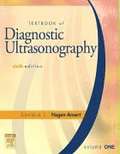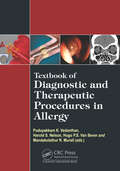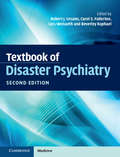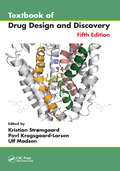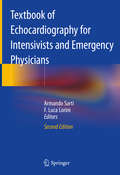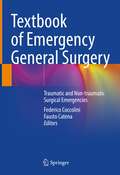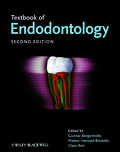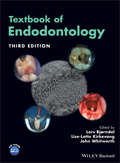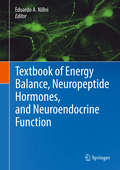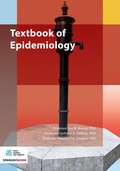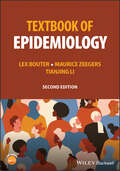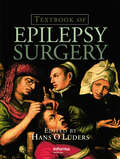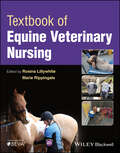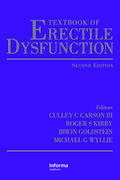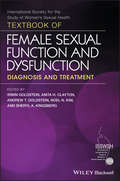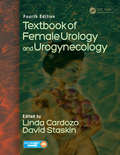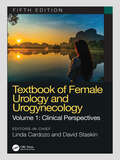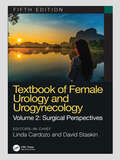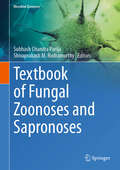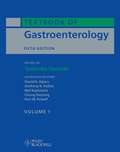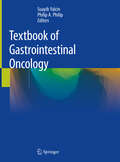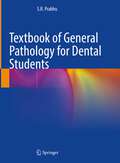- Table View
- List View
Textbook of Diabetes: A Clinical Approach
by Allan Flyvbjerg Barry J. Goldstein Richard I.g. Holt Clive S. CockramOver three editions the Textbook of Diabetes has built a reputation as a book that is extremely well-organized and easy to navigate, with exceptional illustrations and an excellent blend of clinical and scientific content. Previously edited by John Pickup and Gareth Williams this fourth edition has four brand new editors from across the globe. The editors have assembled an outstanding set of international contributors who provide insight on new developments in diabetes care and information on the latest treatment modalities used around the world. The new Textbook of Diabetes has been restructured into 12 parts in one accessible volume and is designed with the busy diabetes care team in mind. As well as retaining the elements that have made it such a popular brand, such as the outstanding full colour illustrations and text design, the new edition sees even greater emphasis on the clinical aspects of diabetes, with new chapters on managing patients with diabetes, the treatment of diabetes, and the delivery and organization of diabetes care, including: Non-insulin parenteral therapies New technologies for insulin administration and glucose monitoring The role of the multidisciplinary team There is also a companion website accompanying the book containing essential bonus material such as: Over 150 interactive MCQ's to help you improve and test your clinical knowledge All 500 figures from the book in a downloadable format to use in slides and presentations Chapter pdfs and chapter references with full links to PubMed If you want a modern, well-illustrated, international guide to diabetes this is the ideal reference book for you.
Textbook of Diagnostic Ultrasonography: Volume One, Sixth Edition
by Sandra L. Hagen-AnsertThis textbook serves as an in-depth resource for students studying sonography, as well as for practitioners in hospitals, clinics, and private radiology, cardiology, and obstetric settings. This sixth edition strives to keep abreast of the rapid advancements, providing students and practitioners with the most complete and up-to-date information in the field of medical sonography.
Textbook of Diagnostic Ultrasonography: Volume Two (Sixth Edition)
by Sandra L. Hagen-AnsertThe Textbook of Diagnostic Ultrasonography divided into two volumes. Volume One covers general ultrasound applications, techniques, and scan protocols and introduces abdominal anatomy and physiology and the general health history analysis. Sonography of the abdomen, superficial structures, and pediatrics are also found in Volume One. Volume Two focuses on cardiovascular applications and obstetrics and gynecologic sonography.
Textbook of Diagnostic and Therapeutic Procedures in Allergy
by Pudupakkam K. Vedanthan Harold S. Nelson Hugo P.S. Van Bever Mandakolathur R. MuraliThe uniqueness of this textbook lies in the fact that, it is the FIRST book in the field of allergy addressing in detail the various diagnostic and therapeutic procedures. The rationale behind presenting this book is to appraise the reader regarding the underlying principles of such procedures and to identify the limitations as well as usefulness in clinical practice. The chapters do include both traditional and modern methodologies representing the global nature of the specialty. Authors have been drawn across the globe to represent the variety of such procedures used in clinical medicine. This textbook will be appealing to medical students, physicians-in-training as well as consultants.
Textbook of Disaster Psychiatry, Second Edition
by Robert J. Ursano Fullerton Carol S. Lars Weisaeth Beverley RaphaelCovering both natural and man-made scenarios including war and terrorism, the Textbook of Disaster Psychiatry is a vital international reference for medical professionals, community leaders and disaster responders a decade after its initial publication. Spanning a decade of advances in disaster psychiatry, this new and updated second edition brings together the views of current international experts to offer a cutting-edge comprehensive review of the psychological, biological and social responses to disaster, in order to help prepare, react and aid effective recovery. Topics range from the epidemiology of disaster response, disaster ecology, the neurobiology of disaster exposure, to socio-cultural issues, early intervention and consultation-liaison care for injured victims. The role of non-governmental organizations, workplace policies and the implications for public health planning at both an individual and community level are also addressed. The comprehensive examination of disaster and its impact gives the book both clinical and public health relevance The text has been updated to cover a decade of advances, leading to more effective approaches to preparation, treatment, intervention and therefore recovery Concepts and approaches are applied to worldwide needs, resulting in a text relevant to real life practice
Textbook of Drug Design and Discovery (Fifth Edition)
by Ulf Madsen Kristian Stromgaard Povl Krogsgaard-LarsenBuilding on the success of the previous editions, the Textbook of Drug Design and Discovery, Fifth Edition, has been thoroughly revised and updated to provide a complete source of information on all facets of drug design and discovery for students of chemistry, pharmacy, pharmacology, biochemistry, and medicine. The information is presented in an up-to-date review form with an underlying and fundamental focus on the educational aspects. Beginning with an introduction to drug design and discovery, the first eight chapters cover molecular recognition, ligand-based drug design, and biostructure-based drug design. The authors also discuss drug-like properties and decision making in medicinal chemistry, chemical biology, natural products in drug discovery, and in vivo imaging in drug discovery. The middle six chapters provide an overview of peptide and protein drug design, prodrugs in drug design and development, and enzyme inhibitors. The authors also go through receptors (structure, function, and pharmacology), ion channels (structure and function), and neurotransmitter transporters (structure, function, and drug binding). The following chapters address important neurotransmitter systems, GABA and glutamic acid receptors and transporter ligands, acetylcholine, histamine, dopamine and serotonin, and opioid and cannabinoid receptors. The book concludes with an examination of neglected diseases, anticancer agents, tyrosine kinase receptors, and antibiotics.
Textbook of Echocardiography for Intensivists and Emergency Physicians
by Armando Sarti F. Luca LoriniThe second edition of this superbly illustrated book equips practitioners with all the information that they will require in order to perform echocardiography appropriately and to interpret findings correctly. After clear exposition of fundamentals of the examination technique via both the transthoracic and the transesophageal approach, the functional anatomy of all normal and pathologic thoracic structures as observed on echocardiography is presented in detail. A wide range of basic and advanced applications of echocardiography in the emergency, perioperative, and intensive care settings are then described. A final supplementary section considers further applications of ultrasound in the ICU, such as in patients with respiratory failure, trauma, or venous thrombosis. This edition has been extensively revised and updated and includes entirely new chapters on various techniques and applications. It will be a tremendous aid to current best practice for all intensivists, emergency physicians, and anesthesiologists who intend to use echocardiography and ultrasound for diagnosis and guidance of optimal management in the critically ill.
Textbook of Emergency General Surgery: Traumatic and Non-traumatic Surgical Emergencies
by Fausto Catena Federico CoccoliniThis text aims to provide a comprehensive review of general emergency surgery, the branch of medicine that treats patients presenting to the hospital with a wide variety of emergency conditions. It includes a section focusing on clinical aspects, management, logistics, patient cohorts and perioperative considerations in the context of general emergency surgery and trauma. Other sections describe various conditions and diseases in specific anatomical structures to enable readers to easily find the information they need. Written and edited by international experts and opinion leaders in the field, this book is a valuable reference resource for general and emergency surgeons, trauma surgeons, emergency physicians and nurses. It will also be of interest to residents, students and all other healthcare professionals involved in the management of emergency surgical patients.
Textbook of Endodontology
by Gunnar Bergenholtz Claes Reit Preben Hørsted-BindslevThe second edition of Textbook of Endodontology continues the aim of serving the educational needs of dental students and dental practitioners searching for updates on endodontic theories and techniques.Significantly restructured and completely updated, the new edition maintains the ethos of the original, facilitating ease of learning through pedagogical features such as annotated references, core concepts and key literature. It features a number of new chapters on topics ranging from outcomes of endodontic treatment to managing endodontic complications to dental trauma. Additionally, all other chapters have been thoroughly revised and brought up to date to reflect contemporary knowledge and practice.Textbook of Endodontology continues its important function of providing lucid scholarship and clear discussion of biological concepts and treatment principles in endodontics, and as such will be an important update to its current readers and a valuable discovery to its new audience.
Textbook of Endodontology
by Lars Bjørndal Lise-Lotte Kirkevang John WhitworthThe third edition of Textbook of Endodontology provides lucid scholarship and clear discussion of endodontic principles and treatment to dental students and dental practitioners searching for current information on endodontic theories and techniques. Completely revised and updated new edition Features six new chapters Provides pedagogical features to promote understanding Includes clinical case studies to put the information in the clinical context Illustrated in full color throughout with clinical images and detailed diagrams Offers interactive multiple-choice questions on a companion website
Textbook of Energy Balance, Neuropeptide Hormones, and Neuroendocrine Function
by Eduardo A. NillniThis textbook presents for the first time a comprehensive body of the latest knowledge in the field of neuropeptides and their action on energy balance. It contains a detailed and comprehensive account of the specific hypothalamic peptides in regards to their roles in energy balance, food intake control and co-morbidities, to better understand the patho-physiology of obesity.The textbook includes an examination the history of the evolution of human society from a thin to the obese phenotype and, within that context, how modern society habits and industrial food production did not respect the evolutionary trait resulting in changes in the energy balance set point. It provides a novel conceptualization of the problem of obesity when considering the biochemistry of peptide hormones and entertaining novel ideas on multiple approaches to the problems of energy balance, as well as demonstrates and explains why alterations in pro-hormone processing are paramount to understand metabolic disease. This text is excellent material for teaching graduate and medical school courses, as well as a valuable resource for researchers in biochemistry, cell, and molecular biology, neuroscientists, physician endocrinologists, and nutritionists.
Textbook of Epidemiology
by G. A. Zielhuis L. M. Bouter M. P. ZeegersEpidemiological research is an important tool for the improvement of preventive and curative healthcare. A valid study design, unbiased study conduct and proper interpretation of study results are essential, as these provide the foundation for evidence-based medicine. This book provides guidance on how to design, conduct and interpret human population-based medical research. It reflects the diversity in the field and will therefore discuss the methodology of etiological, diagnostic, prognostic and intervention research. This textbook is written for bachelor’s and master’s degree students receiving training in the biomedical sciences and for practitioners in the medical and allied professions. It will also serve as a reference manual for those with basic or advanced experience of epidemiology.Commissioned by the European Epidemiology Federation.
Textbook of Epidemiology
by Maurice Zeegers Tianjing Li Lex BouterTEXTBOOK OF EPIDEMIOLOGY The gold standard in epidemiological texts In the second edition of Textbook of Epidemiology, a distinguished team of researchers deliver an extensively updated and comprehensive exploration of epidemiological methods, illuminating the tools for studying the distribution and risk factors of health states and events in populations. An introduction to epidemiological methods with recent and broadly applicable examples End-of-chapter self-assessment questions for readers to check their understanding of key concepts, with answer keys and further enrichment materials available on a companion website A brand-new chapter covering methods for systematic reviews and meta-analysis Accessible material appropriate for clinical practitioners and researchers from around the world Perfect for professionals working in clinical medicine and public health, Textbook of Epidemiology will also earn a place in the libraries of allied health professionals seeking a one-stop resource or to re-immerse themselves in specific methodological topics and practices.
Textbook of Epilepsy Surgery
by Hans O LüdersTextbook of Epilepsy Surgery covers all of the latest advances in the surgical management of epilepsy. The book provides a thorough understanding of epileptogenic mechanisms in etiologically different types of epilepsy and explains neuronavigation systems. It discusses new neuroimaging techniques, new surgical strategies, and more aggressive surgic
Textbook of Equine Veterinary Nursing
by Rosina Lillywhite Marie RippingaleDiscover a practical approach to equine veterinary nursing care, for use in clinical practice and education. Textbook of Equine Veterinary Nursing provides an introduction to the required knowledge and fundamental skills involved with veterinary nursing care for equine patients. It is a rigorous and comprehensive resource for any individual working in the equine veterinary industry, covering core topics including anatomy and physiology, clinical examination, medication administration, husbandry, infection control, and critical care for equine patients. Specific nursing care requirements for neonates and donkeys are also included. Textbook of Equine Veterinary Nursing readers will also find: Detailed discussion of topics including applied equine welfare, equine medical and surgical disorders, and equine anaesthesiaInformation, revision aids, and exam guidance specific to the current syllabi for the equine veterinary nursing qualificationAdvice on career progression, further qualifications, and training in equine care Written by a team of experienced equine veterinary nurses and equine veterinary surgeons and based on evidence-based research, Textbook of Equine Veterinary Nursing is ideal for equine veterinary nurses, student equine veterinary nurses, veterinary students and equine science students. This textbook can also be used for higher education equine courses.
Textbook of Erectile Dysfunction
by Culley C Carson Roger S KirbyErectile dysfunction (ED) affects 20-30 million American men, most of whom are over 50 years of age. In a UK-based study, 32% of British men had difficulty obtaining an erection, 20% with maintaining an erection. In recent years the physiology and pathophysiology of ED have changed our understanding of what ED is from a purely psychological-b
Textbook of Female Sexual Function and Dysfunction: Diagnosis and Treatment
by Anita H. Clayton Irwin Goldstein Andrew T. Goldstein Noel N. Kim Sheryl A. KingsbergA comprehensive text on female sexual function and dysfunction that offers a multi-disciplinary, biopsychosocial approach to diagnosis and treatment Textbook of Female Sexual Function and Dysfunction offers a multi-disciplinary, biopsychosocial approach and provides guidance for the safe and effective diagnosis and treatment of various sexual health issues. With contributions from an international panel of experts, the text provides the scientific basis of the clinical recommendations for dealing with problems of sexual, desire, arousal, orgasm and pain. The text is clearly organised around the four major disease states in female sexual dysfunction (FSD) and is officially endorsed by the International Society for the Study of Women's Sexual Health (ISSWSH). The authors cover a wealth of topics such as hypoactive sexual desire disorder, psychological management of sexual disorders, anatomy and physiology of sexual dysfunction and pain and information on future developments and research. In addition, the text reviews all FDA approved medications for sexual dysfunction and contains consideration of off-label treatments for FSDs. This important text: • Offers the only textbook to highlight female sexual dysfunction in light of recently approved FDA medications • Contains a unique biopsychosocial approach from a collaborative team of physicians, psychologists, physical therapists as well as other sexual health professionals • Presents a comprehensive text led by one of the foremost global experts in Women's Sexual Health, Irwin Goldstein, founder of ISSWSH, with three other past presidents and one president-elect Written for any professional dealing with women's sexual health, Textbook of Female Sexual Function and Dysfunction offers an invaluable guide to the most safe and effective diagnosis and treatment.
Textbook of Female Urology and Urogynecology - Two-Volume Set
by Linda Cardozo David StaskinFeaturing contributions by an international team of the world’s experts in urology and gynecology, this fourth edition reinforces its status as the classic comprehensive resource on female urology and urogynecology and an essential clinical reference in the field.
Textbook of Female Urology and Urogynecology: Clinical Perspectives
by Philip Toozs-Hobson Linda Cardozo Roger R. Dmochowski Eric S. Rovner David Staskin Christian Phillips Peter K. Sand Victor W. Nitti Lori A. Birder Rufus Cartwright Nikki Cotterill Ian Milsom Dudley RobinsonFeaturing contributions by an international team of the world’s experts in urology and gynecology, this fifth edition reinforces its status as the classic comprehensive resource on female urology and urogynecology and an essential clinical reference in the field, with new chapters throughout. Each volume is now available separately. *Offers a comprehensive guide to medical aspects *Covers important classic and newer topics *Presents a practical and manageable level of detail
Textbook of Female Urology and Urogynecology: Surgical Perspectives
by Philip Toozs-Hobson Linda Cardozo Roger R. Dmochowski Eric S. Rovner David Staskin Christian Phillips Peter K. Sand Victor W. Nitti Lori A. Birder Rufus Cartwright Nikki Cotterill Ian Milsom Dudley RobinsonFeaturing contributions by an international team of the world’s experts in urology and gynecology, this fifth edition reinforces its status as the classic comprehensive resource on female urology and urogynecology and an essential clinical reference in the field. There are new chapters throughout and new commentaries on important documents in the appendixes; each volume is now available separately. *Offers a comprehensive guide to surgical aspects *Covers important and common topics such as pelvic organ prolapse and robotic surgery and newer topics such as transgender surgery *Presents a practical and manageable level of detail
Textbook of Forensic Science
by Pankaj Shrivastava Ankit Srivastava Neeti Kapoor Ashish Badiye Jose Antonio LorenteThis textbook provides essential and fundamental information to modern forensics investigations. It discusses criminalistics and crime scene aspects, including investigation, management, collecting and packaging various types of physical evidence, forwarding, and chain of custody. It presents fundamental principles, ethics, challenges and criticism of forensic sciences and reviews the crime typologies, the correlates of crime, criminology, penology, and victimology. It provides a viewpoint on legal aspects, including types of evidence, the procedure in the court and scrutiny of the evidence and experts. The book summarizes forensic serological evidences such as blood, semen, saliva, milk-tears, sweat, vaginal fluids, urine, and sweat. It also provides an overview of forensic examination of different types of evidence and also includes comprehensive detailing of forensic ballistics including firearm classification, bullet comparison and matching. Further, it explores the examinations of drugs, chemicals, explosives, and petroleum products. It focuses on the various aspects of forensic toxicology, including the study of various poisons/toxins, associated signs and symptoms, a fatal dose /fatal period of poisons. The book also emphasizes digital and cyber forensics, including classification, data recovery tools, encryption and decryption methods, image, and video forensics.It is a useful resource for graduate and post-graduate students in the field of Forensic Science.
Textbook of Fungal Zoonoses and Sapronoses (Microbial Zoonoses)
by Subhash Chandra Parija Shivaprakash M. RudramurthyThis textbook, which is the second volume of the book series-Microbial Zoonoses, provides a comprehensive overview of the epidemiology, clinical features, diagnosis, and management of fungal zoonoses and sapronoses of public importance. The book is divided into two volumes; the chapters in the first volume deals with the general introduction, taxonomy and genomic analysis, classification of fungus, pathogenesis and immunology of fungal infections. The subsequent chapters in this section provide an overview of the epidemiology, diagnosis, antifungal agents available for treatment, management, and prevention of fungal zoonoses and sapronoses. It also classifies anti-fungal agents and discusses the mechanism of resistance to these agents. Lastly, it presents the challenges in the treatment of the fungal diseases. The second section discusses important fungal infections and disease causing fungal agents. It also provides information on the pathogenesis, pathology, immunology and clinical manifestations. Cutting across the disciplines, this book act as a guide to the undergraduate and post graduate students of medicine, veterinary and allied sciences who deals with fungal infections.
Textbook of Gastroenterology
by Tadataka Yamada Neil Kaplowitz Anthony N. Kalloo Chung Owyang Don W. Powell David H. AlpersOver the past twenty years, thousands of physicians have come to depend on Yamada's Textbook of Gastroenterology. Its encyclopaedic discussion of the basic science underlying gastrointestinal and liver diseases as well as the many diagnostic and therapeutic modalities available to the patients who suffer from them was--and still is--beyond compare. This new edition provides the latest information on current and projected uses of major technologies in the field and a new section on diseases of the liver. Plus, it comes with a fully searchable CD ROM of the entire content.
Textbook of Gastrointestinal Oncology
by Suayib Yalcin Philip A. PhilipThis textbook discusses core principles and practices in gastrointestinal oncology and covers a wide range of practice areas such as pathology and radiologic images, epidemiology, genetics, staging, multidisciplinary management of specific gastrointestinal cancer, and pathology for each primary tumor site. The comprehensive coverage makes Textbook of Gastrointestinal Oncology a useful resource for the practitioner wishing to gain a greater understanding of the principles of managing malignant gastrointestinal disease, as well as medical oncology fellows, surgeons, radiation oncologists, gastroenterologists and fellows, and residents.
Textbook of General Pathology for Dental Students
by S.R. PrabhuThis textbook is structured to meet the specific learning needs of dental students in general pathology and assist them in holistically formulating clinical decisions. It discusses pathology principles essential to understanding the disease process. The text is presented logically and designed to emphasise clinical relevance where necessary. Chapters on common systemic and orofacial diseases have also been included to highlight the fundamental relevance of pathology to clinical dentistry. Organised in 16 chapters, using a user-friendly writing style, this book covers core topics such as cellular pathology, inflammation, tissue repair, immunopathology, genetic disorders, infectious disease, neoplasia, nutritional and environmental pathology, pain, and pathology of organ systems relevant to the practice of dentistry. It is a must-have for undergraduate and postgraduate dental students.

